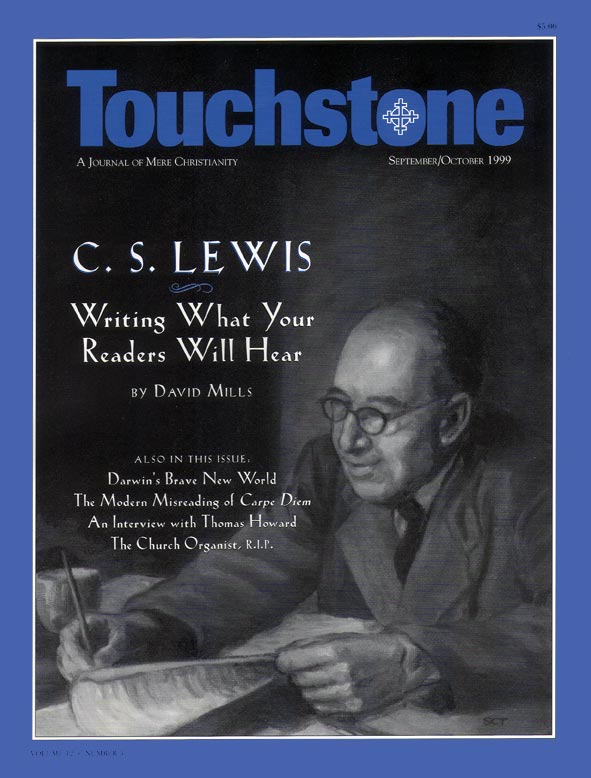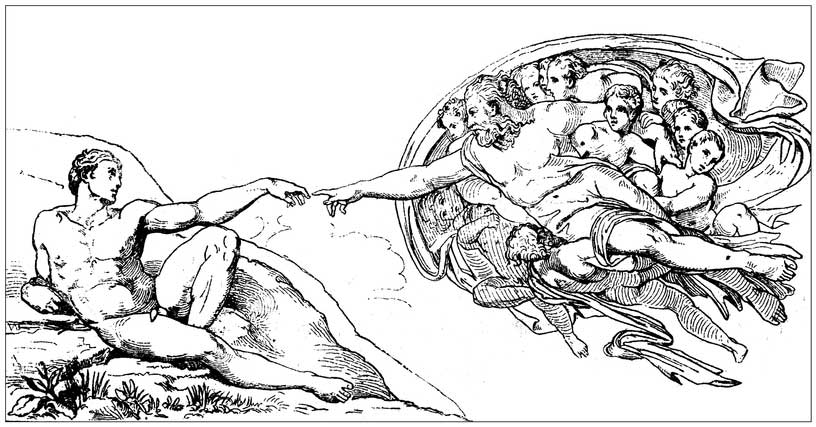The Thames & the Tiber
The Roman Option: Crisis and the Realignment of English-Speaking Christianity
by William Oddie
London: HarperCollins Publishers, 1997
(256 pages; £16.99 [= c. $28.50], cloth)
reviewed by William J. Tighe
On November 11, 1992, the General Synod of the Church of England decided, by a margin of two votes in its House of Laity, to approve a bill to open its priesthood to women. This book is essentially an account of the consequences of that decision for the Church of England—in particular, its now declining and divided Anglo-Catholic party—and for the Roman Catholic Church in England. In consequence of the decision, the Roman Catholic Church was (and still is, says the author) faced with the possibility of a mass influx of alienated and disenchanted Anglo-Catholics. The central focus of the book is on the obscure interactions of a triangle consisting of disaffected Anglicans, the English Catholic episcopate, and the Vatican. This exchange took place between November 1992 and a meeting of the English Catholic bishops in April 1993. The Catholic hierarchy at that point endorsed a disappointingly meager and ungenerous set of provisions for English Anglicans who wanted to enter the Catholic Church and at the same time preserve as much of their “worthy patrimony” as possible.
Although his book focuses on events in Great Britain, Oddie also describes the emergence of the “Pastoral Provision” for American Episcopalians wishing to become Catholics by group or by congregational conversion in the early 1980s, after the admission of women to the priesthood of the Episcopal Church in 1977. Although less accommodating to these Episcopalians than they desired, the American Roman Catholic bishops proved far more generous in the 1980s than their English counterparts were in 1993.
The author, trained as an English Literature scholar, turned from agnosticism to Anglican Christianity in adulthood, and was ordained to the priesthood in the Church of England. As a priest-librarian of Pusey House, the well-known Anglo-Catholic Oxford theological library and think tank, he wrote hard-hitting books and articles on the corrosive effects of feminist thought on orthodox Christianity (What Will Happen to God? Feminism and the Reconstruction of Christian Belief, 1984) and the ongoing self-destruction of “First World” Anglicanism over the past several decades (The Crockford’s File: Gareth Bennett and the Death of the Anglican Mind, 1989). In 1991, a year before the climactic November 1992 vote, Oddie became a Roman Catholic. He has since lived as a layman and religious affairs journalist; he is now editor of the Catholic Herald. His past as an Anglican clergyman and his present Catholic lay status have enabled him to speak with expertise and candor about the Anglican and Roman Catholic Churches in the English-speaking world.
The “Liberal Protestant Ascendancy”
For the Church of England, the most significant consequence of the November 1992 decision is that, according to Oddie, it is “now indisputably and irreversibly in the hands of a liberal Protestant ascendancy.” Looming in the future are bitter battles over the attempts of a powerful homosexual lobby, the Lesbian and Gay Christian Movement (LGCM), to win approval for same-sex partnerships as an acceptable Christian lifestyle for both clergy and laity. Oddie suggests that 20 percent of the membership of the current General Synod are hard-core supporters of the LGCM’s goals, with another 20 percent as sympathizers. Among the more notable supporters of such revisionist Christianity are the so-called affirming Catholics, an Anglo-Catholic group that includes the bishop of Edinburgh, Richard Holloway, and the Welsh Anglican bishop of Monmouth, Rowan Williams.
There is also the matter of women and the episcopate. To ease the passage of the measure allowing for the ordination of women to the priesthood, the female episcopate was specifically excluded. This was a purely tactical device to give an appearance of provisionality to the female presbyterate, but now, for that very reason, to be withdrawn with all convenient speed. In Oddie’s view, the inevitable ordination of women bishops is only retarded by the reluctance of the Church of England’s episcopate to acknowledge the fundamental “liberal Protestant shift” in the nature of Anglicanism, and hence to facilitate the amicable departure of those within its bosom unalterably opposed to this development.
Archbishop Carey’s “Moral Absolutes”
At this point George Carey, the archbishop of Canterbury, emerges unexpectedly as one of the protagonists of the book. True, he was an assiduous promoter of the ordination of women. In the aftermath of the vote he was so far from comprehending the principled basis of the opponents’ beliefs that he could urge them “to work with [women clergy] and support their ministry.” But he is, in Oddie’s words, “very firmly against moral relativism, and . . . prepared to take his stand in defense of moral absolutes.” If he can resist the endeavors of the Anglican liberal establishment to undermine him, he could fulfill a historic vocation: “the long overdue work of uniting in one fold, not only the emerging tradition of a New Anglicanism but the whole English Protestant tradition.”
It is an attractive picture, but it begins to dissipate when one considers the nature of the “moral absolutes” that Carey is prepared to uphold. Generally speaking, they are those that old-fashioned secular moralists would endorse, and not those on which the Christian ethic most acutely contradicts the prevenient culture. He is generally adverse, it seems, to the accelerating trend among liberal Protestants to endorse homosexual genital activity, whether “monogamous” or not. He has not, however, forthrightly proclaimed his conviction in season and out. He did clearly state his aversion to it in 1996 at the Episcopal Church’s Virginia Theological Seminary, shortly after that institution effectively endorsed same-sex cohabitation by its students, but he effectively hid his light under a bushel when he came to address the General Convention of the Episcopal Church in Philadelphia in July 1997. He did, however, openly support the conservatives at Lambeth in 1998 on this issue.
Homosexuality aside, however, on what other issues has he demonstrated his endorsement of moral absolutes? His own children have been divorced, and he has endorsed remarriage after divorce as offering the hope of a “new beginning.” He has shunned all association with opponents of abortion, and within the past three years he has disclaimed being “a pro-lifer.” He has, in the Porvoo Agreement, led the Church of England into communion fellowship with some of the most grossly secularized and apostate “state churches” in the world, such as the Church of Sweden and the Church of Norway. And if his primary domestic ecumenical concern is to attract the Methodist and United Reformed churches into close communion with the Church of England, he has chosen denominations as liberal in their quiet way as any of the Scandinavian Lutheran churches. In what respect the unification of English Protestantism on the basis of doctrinal minimalism and moral uncertainty, garnished though it might be with a profession of the existence of moral absolutes in some seventh heaven, might be beneficial for Christianity, Oddie does not inform his readers.
Provisional Provisions for Dissenters
For English Anglo-Catholics the situation can only be regarded as unstable and provisional. After the General Synod’s vote there was widespread outrage at “old guard” Anglo-Catholic leaders, like Eric Kemp, bishop of Chichester, who discouraged radical action by their followers and reassured the liberal establishment of their continued loyalty as Anglicans. In the end, and not without a considerable loss of credibility on the part of the dozen bishops opposed to the ordination of women, a scheme of Provisional Episcopal Visitors (known as “flying bishops”) was erected to care for the parishes and clergy unable to accept the ministrations of female clergy or of bishops who ordained women. To the proponents of the new order, this scheme, along with other accommodations made during the three 1993 sessions of the General Synod, might best be described as designed to provide terminal care to the disaffected.
For the dissidents, however, it has come to savor strongly of a church-within-a-church. The three “flying bishops” have won considerable credibility among those committed to their charge by their theological integrity and pastoral zeal. There is a striking contrast between their courage and the confusion or fecklessness displayed by diocesan bishops opposed to the ordination of women. The fact is that despite their opposition, all of the latter, save for Bishop Kemp, have appointed suffragan (i.e., assistant) bishops who are favorable to the ordination of women. These suffragans have been the ones to ordain women to the priesthood, with the blessing of their own diocesan bishops. In this respect these English bishops have displayed less theological sense than even the invertebrate “conservative bishops” who have opposed the liberal establishment of the Episcopal Church in the United States. And their number continues to decline. Of the forty-four dioceses in the Church of England (including the diocese of Gibraltar, which includes all of continental Europe), only six have bishops who continue to oppose the ordination of women. Of the sixty-eight suffragan bishops, only ten remain opposed.
Since 1992, Forward-in-Faith (an umbrella organization uniting the various groups that arose in opposition to the ordination of women) has forged strong links with “high-church” dissident groups in the Scandinavian Lutheran state churches, especially in Norway and Sweden, forming a sort of “counter Porvoo” to the newly forged links between these bodies. Certain elements in Forward-in-Faith conceived a strong interest in the Polish National Catholic Church (PNCC) in the United States (the one remaining fully orthodox constituent member church of the Old Catholic Union of Utrecht) as a possible source of episcopal oversight and “Catholic communion” should a formal split occur in the English Church. It is doubtful whether such a jerry-built structure would have attracted the support and commitment that it did, had not the Roman Catholic Church appeared so inhospitable to disenchanted Anglo-Catholics. Nevertheless, Forward-in-Faith followed with great interest the evolving relationship between the PNCC and a high-church or “evangelical catholic” group of clergy and laity within the Norwegian Lutheran State Church, the Samraad pa Kirkens Grunn, which seemed likely to leave the State Church and come under the aegis of the PNCC in early 1998. However, in late 1997 about half of the core clerical leadership of the Samraad became Roman Catholics, casting the remainder of the group into disarray.
Caught in the Roman Crossfire
The impact of these events upon the Roman Catholic Church was profound, if also obscure. In the heyday of Anglican-Roman Catholic ecumenical rapprochement from the mid-1960s to the mid-1970s, Pope Paul VI had seconded the remarks of the pioneer ecumenist Dom Lambert Beauduin concerning an Anglicanism “united, not absorbed” in a future reconciliation with the Catholic Church. Now the question became whether, given that any hope of rapprochement between the two bodies had been foreclosed by the Anglican acceptance of women’s ordination (together with the host of doctrinal and moral changes that it both symbolized and portended), some elements of the Anglican “worthy patrimony”—another phrase of Paul VI’s—might be accepted by, and fostered within, the communion of the Holy Roman Church. Here, however, as Oddie clearly demonstrates, the would-be Anglican refugees got caught in the crossfire of the ongoing Roman Catholic disputes about the “meaning of Vatican II” and its dubious emanation, the “spirit of Vatican II,” which have bedeviled the Latin Church ever since that council closed in 1965.
In English Roman Catholicism two different groups strongly opposed even so modest and downscaled an accommodation as the “Pastoral Provision” erected in the United States in the early 1980s. One group exemplifies the old-fashioned English Catholic dislike of Anglicanism—and particularly of the Anglo-Catholic party—which had traditionally taken the form of an indignant and visceral repudiation of the notion that the Church of England was in any sense to be regarded as more “catholic” than any other form of Protestantism. Although the existence of such sentiments is credible, Oddie has uncharacteristically refrained from fleshing out this group by naming names, so it is difficult to apprehend its significance, or to what extent it has sympathizers or advocates among the English Roman Catholic episcopate.
In the other group are those who might loosely be styled the “progressive party,” the self-appointed guardians of the “spirit of Vatican II.” They are ever prone to see backsliding from the reforming impetus of that council in venues so diverse as the reiterated condemnation of contraception; the prophetic admonitions to Anglicans of Popes Paul VI and John Paul II on the likely ecumenical effects of the women’s ordination movement in Anglicanism; the indulgence provided for devotees of the Tridentine Mass; and the disciplining of dissident theologians like Hans Küng and Tissa Balasuriya, together with the censure of others like Eduard Schillebeeckx and Charles Curran. Here Oddie does name names. Crispian Hollis, Roman Catholic bishop of Portsmouth, appears to have played a key role in undermining support for the generous provisions that the cardinal archbishop of Westminster, Basil Hume, was originally willing to accord the refugee Anglicans. Also, the “progressive” tendencies of Fr. Oliver McTernan, a priest of the Westminster diocese, are presented as examples of the unanticipated hostility that these Anglicans (and those aiming to facilitate their conversion) would meet.
In any event, those few ungenerous provisions that did emerge from the English Catholic bishops’ meeting in April 1993 have been implemented, when at all, in a most minimalist fashion, save in Cardinal Hume’s own Westminster archdiocese, and in all cases they have been “sold” as a temporary device to facilitate the converts’ full integration into the English Roman Catholic community. All of this betokens, as Oddie rightly suggests, a deep fear that an influx of Anglo-Catholics, conservative in matters theological and liturgical if liberal politically, might threaten the mildly but consistently “progressivist” dominance of the English Catholic clerical bureaucracy that, especially in the case of the bishops, sets great store on friendly relations with their Church of England counterparts. Cardinal Ratzinger, according to Oddie, once inquired, “What are the English bishops afraid of?”, and the pope asked, “Why are the English bishops so unapostolic?” Oddie himself remarks that the episode revealed within the Catholic Church “dark cold places, where resentment, suspicion and all uncharitableness yet lurked.”
And he well might have added “heresy and modernism,” if the discerning reader associates the role of Bishop Hollis of Portsmouth, on the one hand, in spearheading the opposition to a generous provision for the disaffected Anglo-Catholics, with, on the other, his curious inactivity when Mary Grey, “Professor of Feminism and Christianity” at the Dutch University of Nijmegen, and herself a radical feminist “Catholic” supporter of the “goddess movement,” was appointed to the Chair of Catholic Theology at Southampton University. The university as such is not a Catholic institution, but the professorship was under Catholic ecclesiastical sponsorship, and Bishop Hollis, as chairman of the professorship selection committee, was well placed to veto the choice of such an unchristian feminist had he the least desire to do so. But he did nothing.
The book also by implication raises questions about the leadership capacity of the late Cardinal Hume, whose strong, if discriminating, enthusiasm for what he initially termed “a big moment of grace, . . . the conversion of England for which we have prayed all these years,” wilted quickly in the face of opposition stemming so largely from unworthy motives. Oddie is characteristically forthright in revealing the essential vacuity of the rationale advanced by the cardinal in November 1993 in support of the thesis that the more generous American “Pastoral Provision” is unsuitable to English conditions.
Puzzling Omissions
There are a few questions occasioned by the various topics treated (or not treated) in the book. There is, first, the offhand and cavalier dismissal of the “Orthodox Option.” By November 1997 some 240 former clergy of the Church of England had been received into the Roman Church (not including those who became Catholic after their retirement), but some 50 have become Orthodox. Early in the book Graham Leonard is quoted as writing of the Orthodox churches that “while they are sympathetic, they are so closely related in this country to the indigenous Churches of which they are part that it is difficult to see this as a realistic possibility.”
Since the subject of the book is the “Roman Option” and not the “Orthodox Option” the scant treatment accorded it should cause no complaint. What does give cause, though, is the threadbare and question-begging dismissal of Orthodoxy on the grounds of, in effect, “ethnicity.” If the Pearl of Great Price has been safeguarded most authentically in the Holy Tradition of the Orthodox Communion (and I write not as a member of that Communion), then the ethnicity and general “outlandishness” of its English manifestations ought to be a price—or a cross—willingly borne by the wise merchants in search of the Pearl.
Second, there is the matter of the conditional ordination of the former bishop of London, Graham Leonard, to the Catholic priesthood in April 1994, to which Oddie alludes without providing much explanation. Since the Roman Catholic Church denies the validity of Anglican Orders, Leonard’s ordination should have been unconditional, as well as preceded by ordination to the diaconate. It turns out, however, that his ordination sub conditione was authorized by the Vatican owing to the participation of an Old Catholic bishop in the 1932 consecration of Bertram Fitzgerald Simpson, who in turn was one of the Anglican bishops who consecrated Harold Edwin Wynn, the Anglican bishop who ordained Graham Leonard a priest in the Church of England. Furthermore, in April 1994 the Secretary of the Congregation of the Doctrine of the Faith in the Vatican wrote to Cardinal Hume to notify him that the pope had dispensed Leonard from receiving ordination to the diaconate. The three other English Anglican bishops who subsequently became Catholics, Richard Rutt, Conrad Meyer, and John Klyberg, on the other hand, were all ordained unconditionally to the diaconate and priesthood, but with the insertion into the rite of a statement from the Decree on Ecumenism of Vatican II and a prayer for the fulfillment in the Catholic priesthood of their former ministry. These insertions had been presented to Rome by the English Catholic Bishops’ Conference and there approved for use in the ordinations of all former Anglican clergy.
As a result of my own inquiries, I have formed the impression that Graham Leonard’s view of the possible benefits of creating or maintaining separate “Anglican use” Catholic congregations, in England at least, is far less sanguine than that of William Oddie. Leonard also appears decidedly more skeptical about the likelihood of future events’ provoking a substantial movement of “Catholic Anglicans” into the Roman Catholic Church provided the English Catholic bishops make more generous provision for the retention of elements of the Anglican “worthy patrimony.” Thus, he would support the full integration of Anglican converts into the English Roman Catholic community.
Finally, there is the delicate matter of the alleged homosexual proclivities and activities of a number of English Anglo-Catholic clergy. In one of the informational soirees that Cardinal Hume sponsored in 1994 for Anglican clergy contemplating conversion, he spoke of his acceptance of married clergy and celibate clergy, but of his inability to accept anything “in between”—a remark that reportedly was received with audible expressions of discontentment by some of the Anglican clergy present there. To what extent the “homosexual angle” served as a reason or an excuse for coolness on the part of leading English Roman Catholics toward the disaffected Anglo-Catholics would be a subject well worth considering, but it receives no attention in this book. As for lesser matters, the Christian name of the English Catholic scholar Eamon Duffy is consistently misspelled as Eammonn and Dom Lambert Beauduin appears once as Dom Albert.
Despite its puzzling omissions, this book should be required reading for observers of the Roman Catholic-Anglican ecumenical scene, as well as for those interested more in the internal permutations of one or both of these Communions in the face of the increasingly anti-Christian secular Western world and its reflection in the growth of revisionist Christianity (or disguised apostasy) in these, as in other, ecclesiastical traditions.
William J. Tighe was Professor of History at Muhlenberg College in Allentown, Pennsylvania, until his retirement in 2024. He is a member of St. Josaphat Ukrainian Catholic Church in Bethlehem, Pennsylvania.He is a senior editor for Touchstone.
subscription options
Order
Print/Online Subscription

Get six issues (one year) of Touchstone PLUS full online access including pdf downloads for only $39.95. That's only $3.34 per month!
Order
Online Only
Subscription

Get a one-year full-access subscription to the Touchstone online archives for only $19.95. That's only $1.66 per month!
bulk subscriptions
Order Touchstone subscriptions in bulk and save $10 per sub! Each subscription includes 6 issues of Touchstone plus full online access to touchstonemag.com—including archives, videos, and pdf downloads of recent issues for only $29.95 each! Great for churches or study groups.
Transactions will be processed on a secure server.
more from the online archives
calling all readers
Please Donate
"There are magazines worth reading but few worth saving . . . Touchstone is just such a magazine."
—Alice von Hildebrand
"Here we do not concede one square millimeter of territory to falsehood, folly, contemporary sentimentality, or fashion. We speak the truth, and let God be our judge. . . . Touchstone is the one committedly Christian conservative journal."
—Anthony Esolen, Touchstone senior editor









